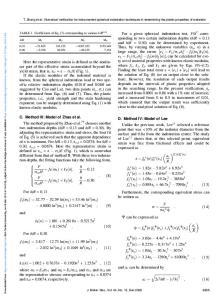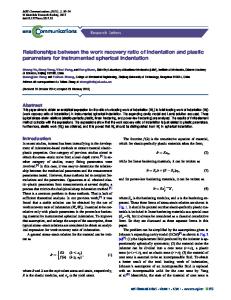Experimental verification for an instrumented spherical indentation technique in determining mechanical properties of me
- PDF / 308,218 Bytes
- 7 Pages / 584.957 x 782.986 pts Page_size
- 108 Downloads / 942 Views
Taihua Zhanga) and Rong Yang State Key Laboratory of Nonlinear Mechanics (LNM), Institute of Mechanics, Chinese Academy of Sciences, Beijing 100190, China (Received 1 November 2010; accepted 18 January 2011)
A spherical indentation-based method and its numerical verification, which is capable of identifying the plastic properties, have been respectively provided by our previous work [P. Jiang, et al., J. Mater. Res. 24, 1045 (2009)] and [T. Zhang, et al., J. Mater. Res. 24, 3653 (2009)]. To examine its effectiveness for practical application, 10 typical metals were selected to perform experimental verifications. Here, the above method was used in combination with the Oliver–Pharr model to avoid its dependence on the previously known elastic modulus. To obtain reliable results, a reasonable calibration has been performed for the used spherical tip with imperfect shape. Finally, the present verification has shown that the deviations of yield strength and elastic modulus obtained from the indentation tests are at most 40% but are generally within 25%. And the effect of the difference in constitutive relationships between the ideal model and the actual material on the accuracy of the indentation-based method has also been illustrated.
I. INTRODUCTION
The instrumented indentation test has become the most successful technique for studying the hardness and modulus of small volumes of materials and thin films. The prospect of extending this technique to estimate plastic properties of materials has come into focus.1,2 However, some early studies have shown that the stress– strain curve cannot be uniquely determined from loading and unloading curves produced by a single sharp-tipped conical indenter.3,4 Although several methods using multiple sharp-tipped indenters have been developed,5–7 operating with multiple indenters is still inconvenient. However, by changing to spherical indentation, it is possible to determine the plastic properties by analyzing the load–depth curve produced by a single indenter.8–13 Consequently, a spherical indentation-based method, which is capable of characterizing plastic properties of materials from just the loading curve of one simple spherical indentation test, was developed in our previous work.14,15 However, our previous method depended on the previously known elastic modulus, which obviously will a)
Address all correspondence to this author. e-mail: [email protected] DOI: 10.1557/jmr.2011.51 1414
J. Mater. Res., Vol. 26, No. 11, Jun 14, 2011
http://journals.cambridge.org
Downloaded: 30 Mar 2015
restrict its application. Fortunately, there are several models available for the extraction of elastic modulus from spherical indenter test data, such as the model proposed by Oliver and Pharr.16 But the question still remains whether the Oliver–Pharr model can be efficiently combined with our previous method for determining both elastic and plastic properties. Moreover, it must be stressed that our previous method was derived based on the power law hardening model, which usually differs fro
Data Loading...











